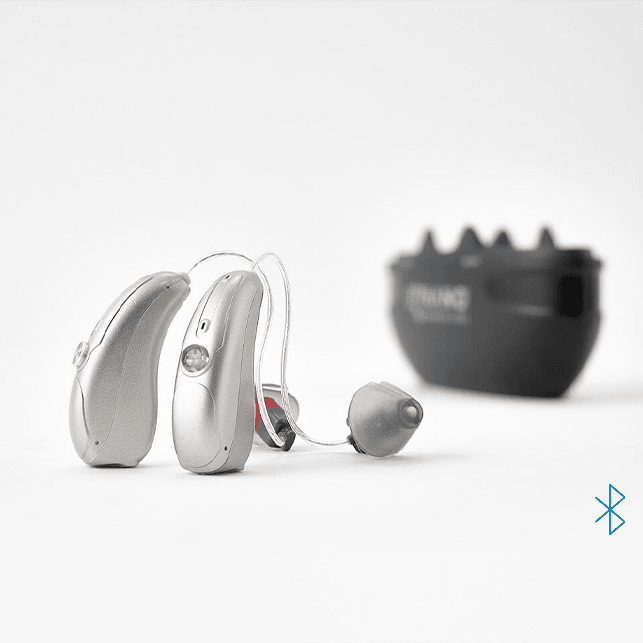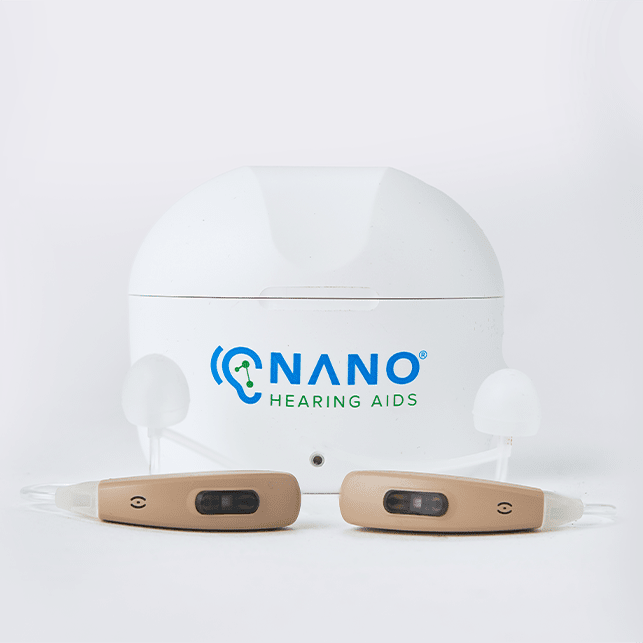Key Takeaways
6 Reasons Why Your Hearing Aids are Squealing or Whistling
These days a lot of hearing aids come with a feedback cancellation feature, but the feedback doesn’t always get totally canceled.
Here are some of the top reasons causing your hearing aids to squeal or whistle:
1. A Poor Fit
The shape and the inside of your ear can change over time just like the rest of your body. Losing or gaining weight can also affect your ears. If this happens, the earmolds of your hearing aids will get loose, and won’t properly seal.
The surrounding sounds will keep leaking out and coming back into the hearing aids, causing the whistling sound or feedback.
C: You can fix this problem by getting new or custom earmolds that perfectly fit your ears. You can also visit your hearing care professional to find the perfect fit. At Nano, we provide our hearing aids with multiple dome sizes to ensure the tight yet comfortable fit.
AT: An elderly person wearing Nano First Ear Plus ITE.

C: Here’s what a pair of Vibe NANO 8 OTC hearing aids look like.
AT: Vibe NANO 8 OTC hearing aids.
2. Very High Volume
Turning up the volume of your hearing aids too much, it might help you hear a bit better, but it can also cause feedback since it can force the surrounding sound to re-enter your device.
You can turn down the volume of your hearing aids to avoid the point that the sound gets too loud and causes feedback.
3. Dislodged and Blocked Microphones
C: You can also clean the holes of the hearing aid microphones gently by using a wax pick or hook. Check out our Accessories page for a hearing aid cleaning kit.
AT: Nano hearing aid cleaning brush.

4. Broken Tubing
The tube connected to the earmold can shrink or harden in the case of some hearing aids. When that happens, the tubing begins to drag the earmold and causes it to not have the perfect fit anymore - causing feedback. You will need to get a new tube to solve this problem.
5. Earwax in the Ears
Earwax (also known as cerumen in medical terms) is something that normally gets produced in our ear canals to keep the ears safe and healthy.
But if there’s too much earwax build up, your ear canal can get blocked. This prevents the sound from your hearing aids from getting through. The sound then bounces back into the hearing aids, causing them to create feedback or whistling.
Excessive earwax can also block your ears, making it harder to hear sounds from your hearing aids and potentially causing earaches or hearing damage. It can also clog earmolds and damage parts of your hearing aids. Regularly clean your ears to avoid these issues and keep your devices working properly.
6. Improper Settings
Sometimes the reason behind whistling or feedback might not be the hardware of the hearing aids, it can be the settings.
If a hearing aid is not properly configured, it can create a similar level of feedback problem to damaged or faulty hearing aids.
Though you can try adjusting your hearing aid by yourself, it's better to get it adjusted by your hearing care professional.
Other Causes
Pros & Cons of Vibe NANO 8 OTC Hearing Aids

Pros of Vibe NANO 8 OTC Hearing Aids

C: The Vibe NANO 8 OTC is designed to fit discreetly inside the ear.
AT: A close-up of the Vibe NANO 8 OTC hearing aid.
Cons of Vibe NANO 8 OTC Hearing Aids
Vibe NANO 8 User Reviews & Testimonials
Here’s what a customer said about the hearing aid.

C: Customers report that hearing has improved after using the Vibe NANO 8.
AT: Screenshot of Vibe NANO 8 customer review.
Why Nano Hearing Aids Might Be Better Than Vibe NANO 8

C: The Nano First Ear Plus CIC model comes with two listening modes - while the Nano First Ear Pro CIC has four program modes.
AT: Nano First Ear Plus CIC and the charging case.
For those looking for an over-the-counter solution to perceived mild to moderate hearing loss, Nano Hearing Aids are an effective and reliable option—and they come in both completely-in-canal (CIC) and behind-the-ear (BTE) styles. Our affordable FDA-registered devices have rechargeable batteries, discreet design, and advanced noise reduction technology.
Frequently Asked Questions:
How do I know if the Vibe NANO 8 is the right fit for my hearing needs?
If you have perceived mild to moderate hearing loss and are looking for a simple, cost-effective solution, Vibe NANO 8 may be a suitable option.
Vibe NANO 8 hearing aids are designed for everyday use, but it's always best to protect them from excessive moisture. While a little sweat or a light drizzle shouldn't be a problem, it's wise to take precautions during more intense activities or in heavy rain.
Yes, Vibe offers a 1-year warranty.
Some Nano Hearing Aids models like the First Ear Plus CIC and First Ear Pro CIC are often chosen over Vibe NANO 8 because they are rechargeable, have easy controls, and come in discreet designs.


